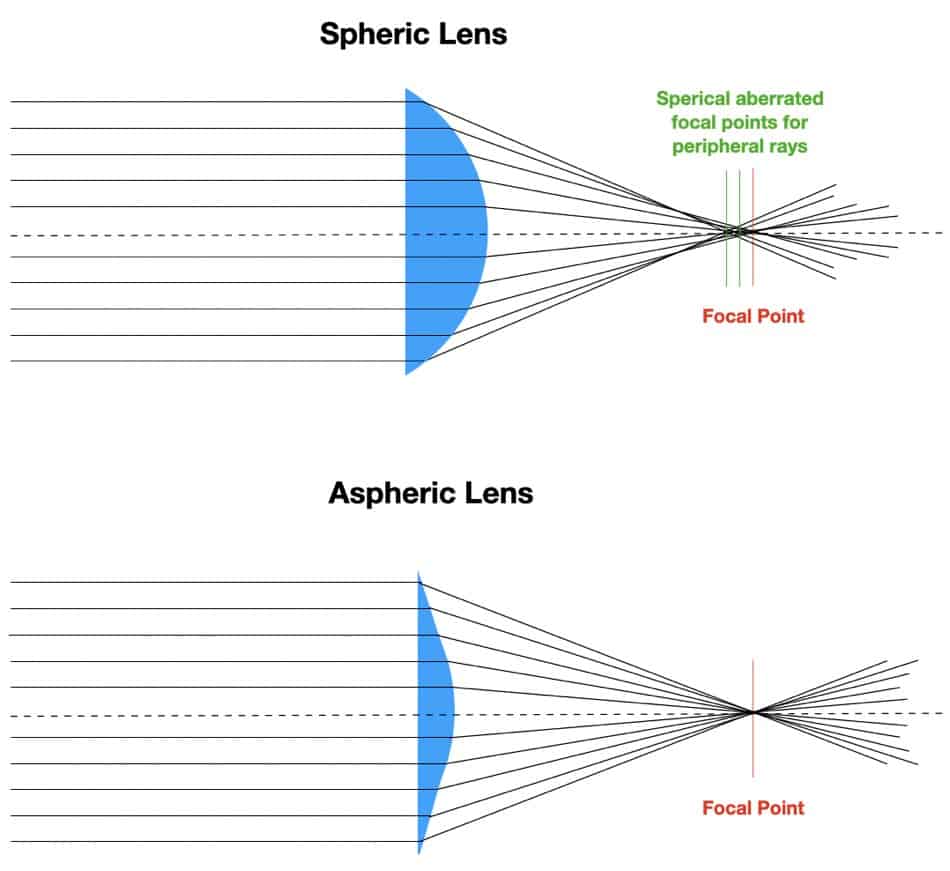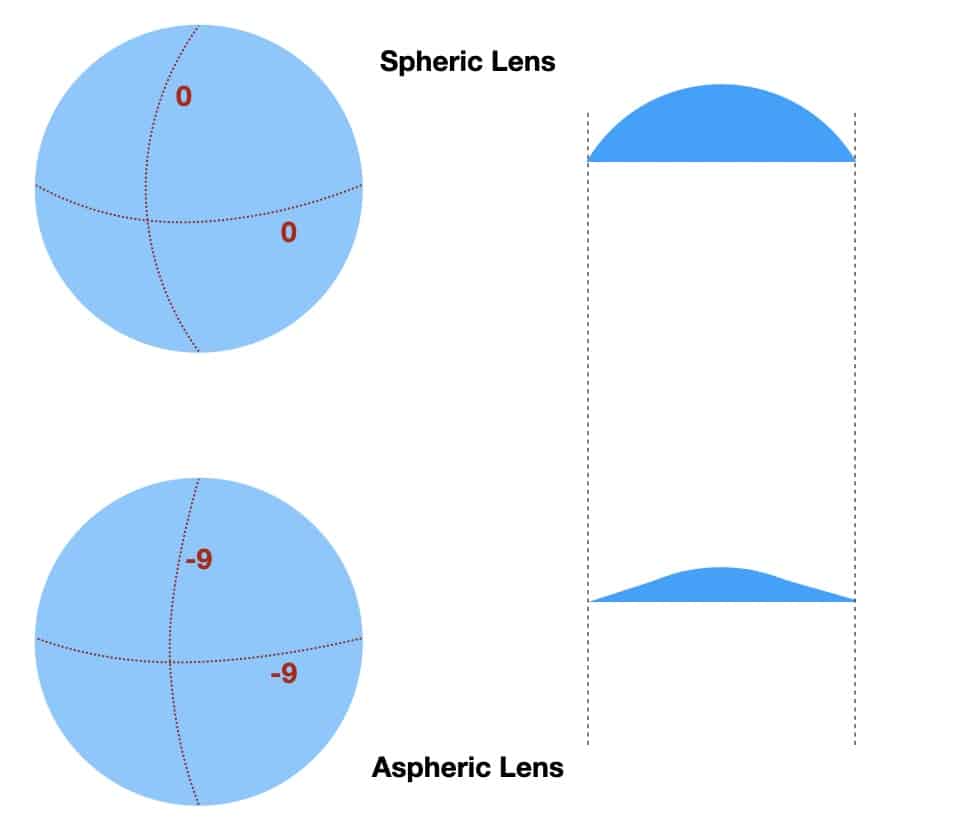Aspheric lenses are worth it if you enjoy an optimal visual experience and your prescription is higher than 4 diopters. There are several aspects to look at in which they are worth it.
- Optical quality gets optimized in the periphery (less blur)
- The lenses become thinner mostly for hyperopes
- The lenses become lighter also mostly for hyperopes
- The magnifying effect gets a little reduced to the decreased thickness
In the picture below you can see how an aspheric lens brings the rays down to one focal point compared to a spheric lens where you will see aberrated focal points as well. You will recognize those aberrated focal points as a blur. The bigger the frame you choose and the higher your prescription is the more blur you will see in the periphery.

Depending on what frame you choose and in which position (more or less tilted and in which distance) aspheric lenses in front of your eyes are totally worth it or not.
The reason is you get aspheric lenses the manufacturers have in stock. As every lens needs to be optimized for some situations they are optimized for average values. So in this case the aspheric lens should sit in 12mm in front of your eyes. If this distance (vertex distance) is changed to let us say 8 mm the asphericity had to be customized to produce optimal optics again.
This is especially true for hyperopes with higher lens powers. Oftentimes I heard from those “I had HD glasses (this is just a marketing term) or aspheric lenses before and they did not work for me at all”.
In most cases, this happened because one measurement (distance or angle) was not looked at correctly and the result was a blur that was not acceptable or a visual experience that the customer did not like. The feeling just was off with these lenses.
How Do Aspheric Lenses Work?
Aspheric lenses work by a change in the lens shape from the center to the periphery of the lens. With this change in the curvature, optics get improved and the wearer of aspheric lenses gets flatter and lighter lenses.
All lenses on the market produce a decent visual experience when it comes to looking straight through them. In such a case you are looking through the center of the lens. But most aberrations reduce optical quality if you look through the lens in an oblique way.
In such a case induced astigmatism will reduce your clear field of view. The changed shape of an aspheric lens compared to a spheric lens makes sure your field of view will be wider with a clear visual experience to enjoy.

Depending on how high your prescription is what lens material you choose and how sensitive you are to those changes in the optical quality you will benefit more or less from aspheric lenses. Most people will notice those changes when the induced astigmatism hits a threshold of 0,25D.
However, this “threshold” is very subjective and when this subjective threshold is reached is not very clear with the different manufacturers. Because they do not have the information handy in regard of the asphericity of their various lens designs.
Let us say the wearer of aspheric lenses looks through his lenses with an angle of 20°. Down below in the table you can see how the curvature of the lenses needs to change (p value) to reduce the induced astigmatism best.
| Sph Lens power | Lens material | P value |
| +6.00D | 1.5 (CR39) | -4 |
| +6.00D | 1.6 (MR-8) | -7,6 |
| +6.00D | 1.67 (MR-7) | -10 |
| -6.00D | 1.5 (CR39) | 0,4 |
| -6.00D | 1.6 (MR-8) | 0,4 |
| -6.00D | 1.67 (MR-7) | 1,2 |
As a wearer of these lenses, this information probably would be not really beneficiary but more of an overkill. The reason is the relation between the asphericity in which the radii of the lens surface changes the front or the back surface. Or even both if you are interested in double aspheric lenses.
When it comes to the aberrations in the periphery myopes have way less to deal with them. Changes to the asphericity were very slightly in comparison to the plus lens in the comparison of the table. As you can see in the picture below with the same size in diameter the lens thickness can be very much reduced with the aspheric lens design.

Although the example here is just an illustration of differences between aspheric lenses and spheric lenses can be very serious. But mostly in plus lenses. But of course, this is already observable in the table above. Because the data already shows the changes in curvature in plus lenses deviate more from the spherical counterpart.
Do I Need Aspheric Lenses?
In most cases, if your prescription is higher than 4 diopters or your astigmatisms are around two diopters or higher. Then you will probably notice a difference between an ordinary spheric design and an aspheric design.
This is always dependent on your individual threshold. In the past, I had customers that did not see a difference with 8 diopters. And I have customers that see a definitive difference between spherics and aspherics with three diopters. But most will find themselves with the information in the first paragraph.
How Much Do Aspheric Lenses Cost?
Prices for aspheric lenses vary a lot. They start at approximately 100$ per lens and go up to 400$. You need always to have a look at the whole package. Prices vary by the index (material) you choose which varies also a little in quality and durability and you have different coatings that are harder or have different qualities in regards to the clean coat.
Here you have some examples for popular aspheric lenses and their brand names.
What Manufacturer Makes Aspheric Lenses?
Every manufacturer makes aspheric lenses. But aspheric lenses are not created equal. Some of the manufacturers have only one aspheric lens surface. Some of the manufactures have aspheric lens surfaces on the front and back surface. As both surfaces get optimized weight will be further reduced as well as thickness.
The Advantages
- lighter lenses
- flatter better-looking lenses
- spheric aberration is reduced = bigger clear field of view
- size of your eyes looks more natural
The Disadvantages
- Some people do not like the visual experience of aspheric lenses
- Aspheric Designs have more limitations compared to atoric designs
- aspheric lenses are not as forgiving when it comes to the centration compared to spheric lenses
The reason therefor oftentimes is not only a parameter that was not measured correctly but also the same change in curvature around all meridians of the lens. Think about it. The aspherical design applies a certain change that makes the lens flatter.
This means the radii change from the center of the lens to the periphery of the lens. When this change is made it can only be optimized for one curvature of the lens. And with toric lenses, this curvature is found in only one meridian. With high astigmatic prescriptions, aspheric lens designs show their limitations.

High Astigmatism and Aspheric Lenses
Here in the example in the picture above you can see the expected clear field of view in white. The blue color illustrates a slight blur. In this example, both lens types have the same prescription with fairly high astigmatism.
You can see immediately the aspheric design, in this case, has more blur and less clear field of view. Because the asphericity of the lens design can only be optimized for the radii of the sphere or astigmatism. In comparison to the right, the atoric lens can be optimized for both.
I wish you a great day.
